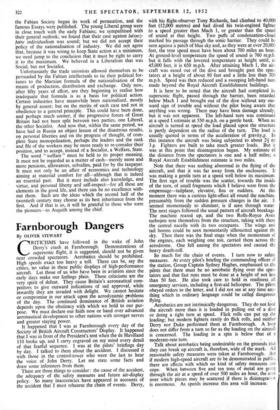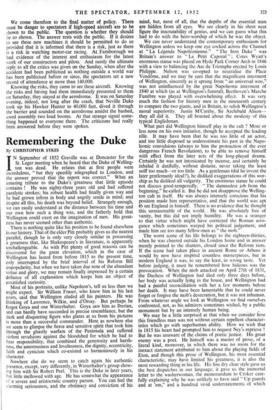Farnborough Dangers
By OLIVER STEWART
CRITICISMS have followed in the wake of John Derry's crash at Farnborough. Demonstrations of supersonic flight, it is suggested, should not be given near crowded spectators. Aerobatics should be prohibited. High speeds exact too heavy a toll. There can be, say the critics, no value in these public displays of high-performance aircraft. Let those of us who have been in aviation since the early days make our feelings Plain. These criticisms are the very spirit of defeat. They cause Britain's aeronautical com- petitors to give outward indications of sad approval, while inwardly they are invaded with delight. We cannot hesitate or compromise in our attack upon the aerodynamic problems of the day. The continued dominance of British aviation depends upon the obstinacy with which we hold to our pur- pose. We must declare our faith now or hand over advanced aeronautical development to other nations with stronger nerves and greater staying power. It happened that I was at Farnborough every day of the Society of British Aircraft Constructors' Display. It happened that I was in front of the President's tent when the de Havilland 110 broke up, and I carry engraved on my mind every detail of that fearful sequence. I was at the pilots' briefings day by day. I talked to them about the accident. I discussed it with those in the control-tower who were the last to hear the voice of John Derry. Let me state some facts and draw some inferences from them.
There are three-things to consider : the cause of the accident, the adequacy of the safety measures and future air-display policy. So many inaccuracies have appeared in accounts of the accident that I must rehearse the chain of events. Derry, with his flight-observer Tony Richards, had climbed to 40,000 feet (12,000 metres) and had dived his twin-engined fighter to a speed greater than Mach 1, or greater than the speed of sound at that height. Two puffs of condensation-cloud marked his passage through the sonic barrier. They could be seen against a patch of blue sky and, as they were at over 20,000 feet, the true speed must have been about 700 miles an hour. At ground-level temperature the speed of sound is 760 m.p.h. but it falls with the lowered temperature at height until, at 45,000 feet, it is 650 m.p.h. After attaining Mach 1, the air- craft was eased out of the dive and brought past the spec- tators at a height of about 80 feet and a little less than 700 m.p.h. Speed was then reduced and a sweeping left-hand turn made beyond the Royal Aircraft Establishment buildings.
It is here to be noted that the aircraft had completed its supersonic flight, passed through the barrier, been retarded below Mach 1 and brought out of the dive without any out- ward sign of trouble and without the pilot being aware that anything was wrong. There may have been damage already; but it was not apparent. The left-hand turn was continued at a speed I estimate at 550 m.p.h. on a gentle bank. When an aircraft is turned at speed the load placed upon the structure is partly dependent on the radius of the turn. The load is usually quoted in terms of the acceleration of gravity,g. In this instance the aircraft was being subjected to about 21 or 3 g. Fighters are built to take much greater loads. But it was at this point that disintegration began. My estimate of the distance from the spectators is one and a half miles; a Royal Aircraft Establishment estimate is two miles.
Note that there was nothing abnormal in the flying of the aircraft, and that it was far away from the enclosures. It was making a gentle turn at a speed well below its maximum, The first sign of trouble was the scatter, towards the inside of the turn, of small fragments which I believe were from the empennage—tailplane, elevator, fins or rudders. At this moment there was a curious light-effect all round the machine, presumably from the sudden pressure changes in the air. It seemed momentaxily to shimmer, is if seen through water. The next stages followed the usual pattern of aircraft breakage The machine reared up, and the two Rolls-Royce Avon turbojets tore themselves from the structure, taking with then the central nacelle with its two occupants. The wings and tail booms could be seen momentarily silhouetted against the sky. Then there was the final stage when the momentum of the engines, each weighing one ton, carried them across the aerodrome. One fell among the spectators and caused the heavy death-roll.
So much for the chain of events. I turn now to safety measures. At every pilot's briefing the commanding officer of the station, Group Captain Sydney Hughes, emphasised to Ile pilots that there must be no acrobatic flying over the spec- tators and that fast runs must be done at a height of not less than 50 feet. He also took care to hold in readiness all emergency services, including a first-aid helicopter. The pilots obeyed orders to the letter, and I did not see at any time any- thing which in ordinary language could be called dangerous flying. Aerobatics are not intrinsically dangerous. They do not lOad the aircraft more than it is loaded in pulling out of a dive or doing a tight turn at speed. Flick rolls can put up the loading; but modem fighters rarely do flick rolls, and neither Deny nor Duke performed them at Farnborough. A loop does not differ from a turn so far as the loading on the aircraft is concerned. The loading in a spin is below that of a moderate-rate turn.
Talk about aerobatics being undesirable on the grounds that they can break up aircraft is, therefore, wide of the mark. All reasonable safety measures were taken at Farnborough. But if modern high-speed aircraft are to be demonstrated in public, there are effects with which no kind of safety measures can cope. When between five and ten tons of metal are going through the air at a speed of over 500 miles an hour, the area over which pieces may be scattered if there is disintegration is enormous. As speeds increase this area will increase. We come therefore to the final matter of policy. There must be danger to spectators if high-speed aircraft- are to be shown to the public. The question is whether they should be so shown. The answer rests with the public. If it desires to see these new machines it should be permitted to do so provided that it is informed that there is a risk, just as there is a risk in watching motor-car racing. At,Famborough we had evidence of the interest and enthusiasm for the latest work of our constructors and pilots. And surely the ultimate reply to all the critics was given on the Sunday, when after the accident had been publicised as nothing outside a world war has been publicised before or since, the spectators set a new record of attendance at more than 140,000.
Knowing the risks, they came to see these aircraft. Knowing' the risks and having had them immediately presented to them on Saturday, they stayed at the aerodrome. It was on Saturday evening, indeed; not long after the crash, that Neville Duke took up his Hawker Hunter to 40,000 feet, dived it through the barrier and sounded on the aerodrome amidst the hushed, awed assembly two loud booms. At that strange signal some- thing happened to everyone there. The criticisms had really been answered before they were spoken.



































 Previous page
Previous page